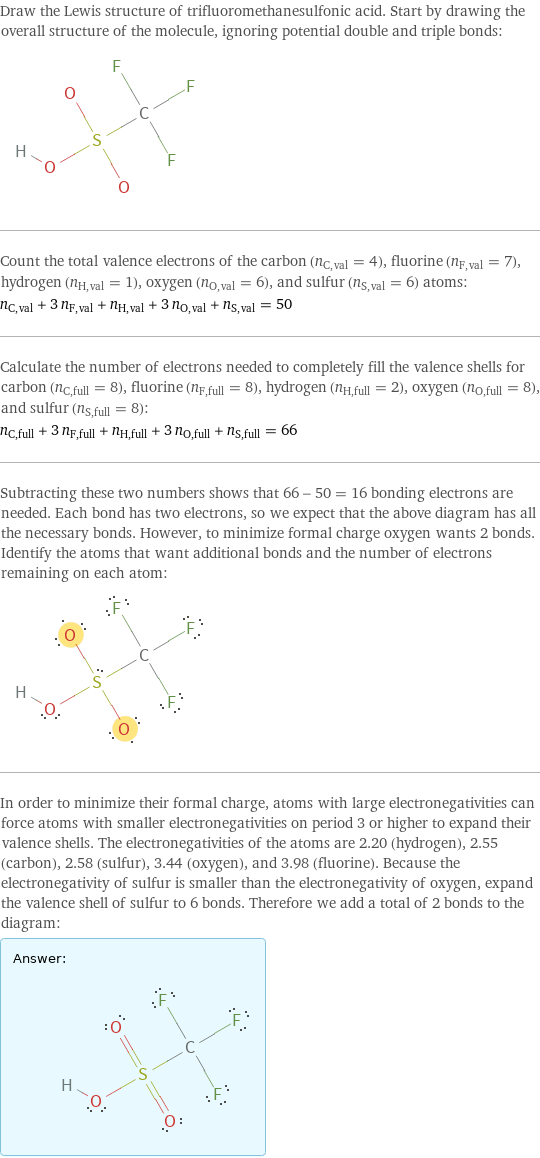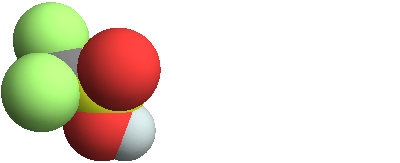Input interpretation

trifluoromethanesulfonic acid
Chemical names and formulas

formula | CF_3SO_3H Hill formula | CHF_3O_3S name | trifluoromethanesulfonic acid alternate names | fluorad fC 24 | perfluoromethanesulfonic acid | triflic acid | trifluoromethylsulfonic acid mass fractions | C (carbon) 8% | F (fluorine) 38% | H (hydrogen) 0.672% | O (oxygen) 32% | S (sulfur) 21.4%
Lewis structure

Draw the Lewis structure of trifluoromethanesulfonic acid. Start by drawing the overall structure of the molecule, ignoring potential double and triple bonds: Count the total valence electrons of the carbon (n_C, val = 4), fluorine (n_F, val = 7), hydrogen (n_H, val = 1), oxygen (n_O, val = 6), and sulfur (n_S, val = 6) atoms: n_C, val + 3 n_F, val + n_H, val + 3 n_O, val + n_S, val = 50 Calculate the number of electrons needed to completely fill the valence shells for carbon (n_C, full = 8), fluorine (n_F, full = 8), hydrogen (n_H, full = 2), oxygen (n_O, full = 8), and sulfur (n_S, full = 8): n_C, full + 3 n_F, full + n_H, full + 3 n_O, full + n_S, full = 66 Subtracting these two numbers shows that 66 - 50 = 16 bonding electrons are needed. Each bond has two electrons, so we expect that the above diagram has all the necessary bonds. However, to minimize formal charge oxygen wants 2 bonds. Identify the atoms that want additional bonds and the number of electrons remaining on each atom: In order to minimize their formal charge, atoms with large electronegativities can force atoms with smaller electronegativities on period 3 or higher to expand their valence shells. The electronegativities of the atoms are 2.20 (hydrogen), 2.55 (carbon), 2.58 (sulfur), 3.44 (oxygen), and 3.98 (fluorine). Because the electronegativity of sulfur is smaller than the electronegativity of oxygen, expand the valence shell of sulfur to 6 bonds. Therefore we add a total of 2 bonds to the diagram: Answer: | |
3D structure

3D structure
Basic properties

molar mass | 150.07 g/mol phase | solid (at STP) melting point | 35 °C boiling point | 162 °C density | 1.696 g/cm^3 solubility in water | very soluble
Units

Solid properties (at STP)

density | 1.696 g/cm^3 vapor pressure | 7.999 mmHg refractive index | 1.327
Units

Chemical identifiers

CAS number | 1493-13-6 Beilstein number | 1812100 PubChem CID number | 62406 PubChem SID number | 24861529 SMILES identifier | C(F)(F)(F)S(=O)(=O)O InChI identifier | InChI=1/CHF3O3S/c2-1(3, 4)8(5, 6)7/h(H, 5, 6, 7)/f/h5H MDL number | MFCD00007514